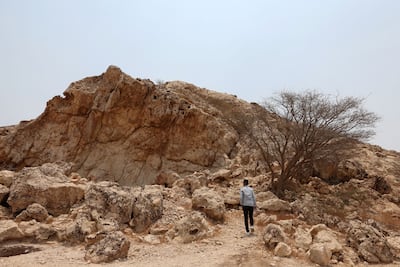An area of huge archaeological significance in Sharjah has won Unesco World Heritage Status.
The Faya palaeolandscape is the second site in the UAE to be placed on the Unesco list – the other is in Abu Dhabi – an achievement that is set to have major knock-on effects for culture and tourism.
It is the culmination of decades of work encompassing excavations, scientific studies, site preservation and careful management of the site.
The ancient desert location in central Sharjah features one of the world’s oldest and most uninterrupted records of early human presence, dating back more than 210,000 years.
The honour was announced at the 47th session of Unesco's World Heritage Committee in Paris on Friday. The Faya site joins a list that includes Egypt's pyramids, India's Taj Mahal and the Great Wall of China.
To be included on the World Heritage List, sites must be of outstanding universal value and meet at least one out of 10 selection criteria, such as being “an outstanding example of a type of building, architectural or technological ensemble or landscape which illustrates (a) significant stage(s) in human history”.
There are two types of world heritage sites – cultural and natural – with Faya listed under the former.
“As one of the most important archaeological sites around the world, Faya palaeolandscape is a living testament to humanity's early presence in this region,” said Sheikha Bodour bint Sultan Al Qasimi, ambassador for the Faya Palaeolandscape World Heritage Nomination.
“For over 210,000 years, this site has borne witness to the story of human innovation, resilience, and adaptation in an arid environment.”
The Faya palaeolandscape refers broadly to the Faya range, a chain of limestone outcrops, and the surrounding area of desert. Today, it is peaceful place of sand dunes and limestone ridges, but what happened there is helping to reshape our understanding of human history.
“The stone tools found at Faya are testimony to the ingenuity of our ancestors and the deep roots of cultural tradition in our region,” said Sheikha Bodour, in a separate statement from state news agency Wam. “We remain fully committed to protecting this site and ensuring its legacy continues to inspire future generations," she said, also expressing thanks to the World Heritage Committee for recognising Faya’s significance.
Over the past 30 years, scientists have excavated the Faya site, uncovering 18 layers, each representing a different period of human occupation. These discoveries have enhanced our understanding of human migration from Faya.
It challenges assumptions that the Arabian Peninsula served only as a corridor for migration from Africa. People may have made a home at Faya and used a southern corridor across modern-day Yemen to settle there. They could have exploited changes in temperatures and rainfall to build longer-term settlements.
Artefacts found at the site, such as handmade tools, indicate a sophisticated level of occupation unique to the area.
Faya was added to Unesco's tentative list in 2023 and formally submitted for nomination last year. The work that has gone into the site – from excavations to studies to research – stretches back decades.
“Faya now belongs to all peoples of the world, just as it did over 200,000 years ago,” said Eisa Yousif, director general of the Sharjah Archaeology Authority, reported Wam.
The UAE has also developed a management plan for the Faya palaeolandscape that will guide its conservation, research and visitor engagement until 2030. This plan aligns with Unesco’s world heritage standards, ensuring the site is preserved while also allowing for continued exploration and education.
Faya was the only Arab site added to the list this year,
The UAE's other entry on the heritage list comprises the cultural sites of Al Ain, which were added collectively in 2011.
Unesco added 26 news sites to the World Heritage list this year.
They include the Diy-Gid-Biy cultural landscape of the Mandara Mountains in Cameroon – ancient archaeological sites surrounded by agricultural terraces and places of worship; and the Mount Mulanje sacred cultural landscape in Malawi.
Guinea Bissau and Sierra Leone had sites added for the first time.
There are now 1,248 sites across the world on the list.
The specS: 2018 Toyota Camry
Price: base / as tested: Dh91,000 / Dh114,000
Engine: 3.5-litre V6
Gearbox: Eight-speed automatic
Power: 298hp @ 6,600rpm
Torque: 356Nm @ 4,700rpm
Fuel economy, combined: 7.0L / 100km
Gothia Cup 2025
4,872 matches
1,942 teams
116 pitches
76 nations
26 UAE teams
15 Lebanese teams
2 Kuwaiti teams
More from Neighbourhood Watch
'How To Build A Boat'
Jonathan Gornall, Simon & Schuster
New schools in Dubai
Company%20Profile
%3Cp%3ECompany%20name%3A%20EduPloyment%3Cbr%3EDate%20started%3A%20March%202020%3Cbr%3ECo-Founders%3A%20Mazen%20Omair%20and%20Rana%20Batterjee%3Cbr%3EBase%3A%20Dubai%2C%20UAE%3Cbr%3ESector%3A%20Recruitment%3Cbr%3ESize%3A%2030%20employees%3Cbr%3EInvestment%20stage%3A%20Pre-Seed%3Cbr%3EInvestors%3A%20Angel%20investors%20(investment%20amount%20undisclosed)%3C%2Fp%3E%0A
Key findings
- Over a period of seven years, a team of scientists analysed dietary data from 50,000 North American adults.
- Eating one or two meals a day was associated with a relative decrease in BMI, compared with three meals. Snacks count as a meal. Likewise, participants who ate more than three meals a day experienced an increase in BMI: the more meals a day, the greater the increase.
- People who ate breakfast experienced a relative decrease in their BMI compared with “breakfast-skippers”.
- Those who turned the eating day on its head to make breakfast the biggest meal of the day, did even better.
- But scrapping dinner altogether gave the best results. The study found that the BMI of subjects who had a long overnight fast (of 18 hours or more) decreased when compared even with those who had a medium overnight fast, of between 12 and 17 hours.
COMPANY%20PROFILE
%3Cp%3E%3Cstrong%3ECompany%20name%3A%3C%2Fstrong%3E%203S%20Money%3Cbr%3E%3Cstrong%3EStarted%3A%3C%2Fstrong%3E%202018%3Cbr%3E%3Cstrong%3EBased%3A%3C%2Fstrong%3E%20London%3Cbr%3E%3Cstrong%3EFounders%3A%3C%2Fstrong%3E%20Ivan%20Zhiznevsky%2C%20Eugene%20Dugaev%20and%20Andrei%20Dikouchine%3Cbr%3E%3Cstrong%3ESector%3A%3C%2Fstrong%3E%20FinTech%3Cbr%3E%3Cstrong%3EInvestment%20stage%3A%3C%2Fstrong%3E%20%245.6%20million%20raised%20in%20total%3C%2Fp%3E%0A
All%20The%20Light%20We%20Cannot%20See%20
%3Cp%3E%3Cstrong%3ECreator%3A%20%3C%2Fstrong%3ESteven%20Knight%3C%2Fp%3E%0A%3Cp%3E%3Cstrong%3EStars%3A%C2%A0%3C%2Fstrong%3EMark%20Ruffalo%2C%20Hugh%20Laurie%2C%20Aria%20Mia%20Loberti%3C%2Fp%3E%0A%3Cp%3E%3Cstrong%3ERating%3A%20%3C%2Fstrong%3E1%2F5%C2%A0%3C%2Fp%3E%0A
Nancy 9 (Hassa Beek)
Nancy Ajram
(In2Musica)
THE SPECS
Engine: 1.5-litre, four-cylinder turbo
Transmission: seven-speed dual clutch automatic
Power: 169bhp
Torque: 250Nm
Price: Dh54,500
On sale: now
Mia Man’s tips for fermentation
- Start with a simple recipe such as yogurt or sauerkraut
- Keep your hands and kitchen tools clean. Sanitize knives, cutting boards, tongs and storage jars with boiling water before you start.
- Mold is bad: the colour pink is a sign of mold. If yogurt turns pink as it ferments, you need to discard it and start again. For kraut, if you remove the top leaves and see any sign of mold, you should discard the batch.
- Always use clean, closed, airtight lids and containers such as mason jars when fermenting yogurt and kraut. Keep the lid closed to prevent insects and contaminants from getting in.
The specs
Engine: 1.5-litre turbo
Power: 181hp
Torque: 230Nm
Transmission: 6-speed automatic
Starting price: Dh79,000
On sale: Now
UAE currency: the story behind the money in your pockets
WHY%20AAYAN%20IS%20'PERFECT%20EXAMPLE'
%3Cp%3EDavid%20White%20might%20be%20new%20to%20the%20country%2C%20but%20he%20has%20clearly%20already%20built%20up%20an%20affinity%20with%20the%20place.%3Cbr%3E%3Cbr%3EAfter%20the%20UAE%20shocked%20Pakistan%20in%20the%20semi-final%20of%20the%20Under%2019%20Asia%20Cup%20last%20month%2C%20White%20was%20hugged%20on%20the%20field%20by%20Aayan%20Khan%2C%20the%20team%E2%80%99s%20captain.%3Cbr%3E%3Cbr%3EWhite%20suggests%20that%20was%20more%20a%20sign%20of%20Aayan%E2%80%99s%20amiability%20than%20anything%20else.%20But%20he%20believes%20the%20young%20all-rounder%2C%20who%20was%20part%20of%20the%20winning%20Gulf%20Giants%20team%20last%20year%2C%20is%20just%20the%20sort%20of%20player%20the%20country%20should%20be%20seeking%20to%20produce%20via%20the%20ILT20.%3Cbr%3E%3Cbr%3E%E2%80%9CHe%20is%20a%20delightful%20young%20man%2C%E2%80%9D%20White%20said.%20%E2%80%9CHe%20played%20in%20the%20competition%20last%20year%20at%2017%2C%20and%20look%20at%20his%20development%20from%20there%20till%20now%2C%20and%20where%20he%20is%20representing%20the%20UAE.%3Cbr%3E%3Cbr%3E%E2%80%9CHe%20was%20influential%20in%20the%20U19%20team%20which%20beat%20Pakistan.%20He%20is%20the%20perfect%20example%20of%20what%20we%20are%20all%20trying%20to%20achieve%20here.%3Cbr%3E%3Cbr%3E%E2%80%9CIt%20is%20about%20the%20development%20of%20players%20who%20are%20going%20to%20represent%20the%20UAE%20and%20go%20on%20to%20help%20make%20UAE%20a%20force%20in%20world%20cricket.%E2%80%9D%C2%A0%3C%2Fp%3E%0A
Lexus LX700h specs
Engine: 3.4-litre twin-turbo V6 plus supplementary electric motor
Power: 464hp at 5,200rpm
Torque: 790Nm from 2,000-3,600rpm
Transmission: 10-speed auto
Fuel consumption: 11.7L/100km
On sale: Now
Price: From Dh590,000
UPI facts
More than 2.2 million Indian tourists arrived in UAE in 2023
More than 3.5 million Indians reside in UAE
Indian tourists can make purchases in UAE using rupee accounts in India through QR-code-based UPI real-time payment systems
Indian residents in UAE can use their non-resident NRO and NRE accounts held in Indian banks linked to a UAE mobile number for UPI transactions











